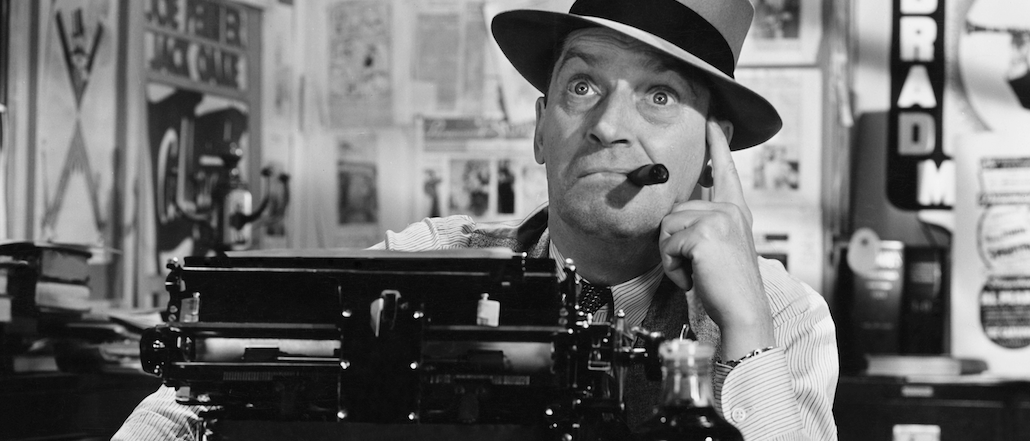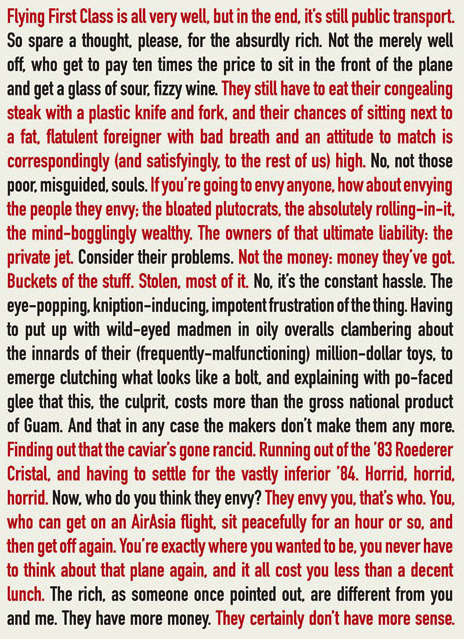
Mark Duffy has written the Copyranter blog for 10 years and is a freelancing copywriter with 20-plus years of experience. His hockey wrist shot is better than yours. Follow him on Twitter.
If you were Hunter S. Thompson, then, yes, I would give you a shot at writing a “native” ad for my brand. I’d give you several shots. But if you were Thompson, you wouldn’t lower yourself to do it. (Plus, you’d be dead. His 2005 suicide was a helluva ambient “shockvertising” ad for the effectiveness of Smith & Wesson products, though.)
You, Columbia boy, you’re not the new Hunter S. Thompson. You’re not even the new Arianna Huffington. Most of you don’t leave your two-screen desks except to take a leak. Can’t miss a *BREAKING* tweet! Gotta be “first” with that all-important re-coverage! You’re a bunch of well-educated wussies.
Why am I, an ad hack who graduated from a state college, daring to besmirch the prestigious, Ivy League world of digital “journalism”? Because even though I really majored in “hockey,” that “j” word is written on my diploma, too. Back in the early 1980s, I was a pre-Internet, portable typewriter-carrying newspaper journalist for six years before I sold out and went to ad school. My pay was five bucks an hour, plus mileage (25¢ a mile). But at least I got off my ass every day to cover a story — even when the story was a county freeholders meeting or yet another tractor pull.
But now, well-educated, delusional, underpaid journalists think that they can do advertising better than ad copywriters. It’s understandable that they think this: They think they can do pretty much everything better than everybody else. I’ve been around enough of them, in close proximity, to form my not-so-well-educated opinion.
There are two reasons why more and more major sites like Huffington Post, Mashable (yuck) and Gawker are paying journalists to write native ads and sponsored posts: They think it makes their money-making content less skeevy, and they think that ad copywriters can’t write long-form as well as journalists.
Both of these reasons are poppycock.
Ad position: web_incontent_pos1
Because journalistic ad posts further blur the line between editorial and advertorial, they’re blatantly more skeevy. And while journalists, generally, may be better at journalistic prose than ad copywriters, CWs (the good ones) know damn well how to write long copy. But theirs, through training, is a different style. It’s entertaining, but it also sells. And if your native ad doesn’t sell (or increase brand awareness) what is it good for? Absolutely nuthin’ (say it again).
So go ahead publishers: keep trumpeting how much your journalistic branded content “respects the audience” more, and rattle off those meaningless click metrics, and quote dubious studies about how people feel “more comfortable” reading journalistic native ads till the cows come home. If it doesn’t work, it doesn’t work. And those chickens will eventually come home to roost (no more bad barnyard cliches, I promise).
Oh, a side note: If you’re letting MarCom or MarTech people write emotionally dead, buzzword-filled branded content, well, that’s even worse. Much, much worse.
Good long ad copy is written like one person talking to another, grammar be damned. Journalists are trained to not write this way. Below is an example of a good long copy ad for Air Asia, written by controversial British adman Neil French. Is it or isn’t a scam ad (something French is semi-famous for)? Honesty, who cares. A substantial amount of the work submitted to Cannes in the last five years has been fake.

Ad position: web_incontent_pos2
Is it entertaining? Yes it is. Does it sell Air Asia to the target demo? It sure the hell does.
This is one example of what a good ad copywriter could do for your brand’s native content. French is far from the best long copy CW in history, but you get the point: Journalists don’t write branded content this way. And that’s to the detriment of your brand, believe me.
Homepage image courtesy of Shutterstock.com
More in Marketing

In the marketing world, anime is following in the footsteps of gaming
As marketers look to take advantage of anime’s entry into the zeitgeist, they might be wise to observe the parallels between the evolution of anime as a marketing channel and the ways brands have learned to better leverage gaming in recent years.

With the introduction of video ads and e-commerce, Roblox looks to attain platform status
Roblox is expanding into more areas than just ads in 2024. Much like platforms such as Amazon and Facebook have transcended their origins to evolve from their origins as online marketplaces and social media channels, Roblox is in the midst of a transformation into a platform for all elements of users’ virtual lives.

PepsiCo wants to remain a ‘driver of culture’ as it turns to influencers and activations amid rebrand
The soda-maker says it can translate cultural relevance into sales volume.
Ad position: web_bfu